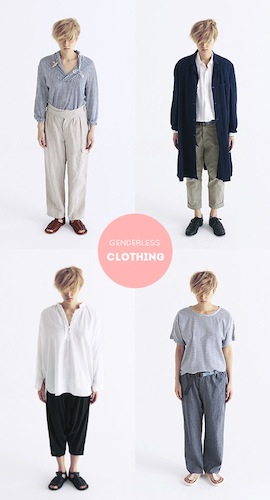
Compiled from www.madewell.com
Fall clothing lines are out, which means the online window-shopper in me is happy as a clam. I’ve been scrolling around, looking for new sweaters or jeans or blazers that would be appropriate for the drastic change in seasons we collectively imagine here in central Texas.
And here’s what I’ve noticed: all the things I like right now have names with the word “boy” in them. Tomboy jackets, boyjeans, boyfriend shirts. Perhaps this is just indicative of a (never-ending) androgynous trend at the places I shop; as the image above shows, just one store—in this case, Madewell— capitalizes on the boyish qualities of their women’s clothes four times in their fall lookbook. Menswear-inspired women’s clothes are nothing new, but they’re definitely on trend in the retail world this fall, in a very self-aware way. Dressing across gender lines can be cool and even a means of subverting traditional gender roles or images. But labeling these styles “boy ____” has, I think, the opposite function.
It got me thinking about some of the strange, patriarchal, normative, and bizarrely long-lasting differences between men’s and women’s clothing design. In particular, one of the most basic differences: how they’re cut.
I’ve recently started designing and making my own clothes, largely inspired by a Japanese designer whose company, Arts & Science, has produced a line of “Genderless Clothes” and consistently produces exquisite, minimalist pieces that anyone could wear.

Image from www.designsponge.com
As I began to experiment with sewing from a pattern, I learned quickly that one of the reasons I love Arts & Science is that their cuts are straight and simple. (Which is great for someone who’s still figuring out her sewing machine. Curves are tricky, y’all.) Patterns for women’s clothes (many of which haven’t changed since, oh, the 1950s) are more often about contouring, curving, and accenting or hugging the woman’s “form.” And this, I think, is where the problems arise.
The answer is obvious, but why is it that most women’s clothing is designed to either a) show off or b) hide the body, while most men’s clothing is designed to comfortably fit the body? The objectifying gaze of patriarchy is right up against you at this moment, fellow wearers of women’s clothes! It’s sewn into your very seams! Even if you’re wearing (like I am right now) a basic white T-shirt. More on that in the next installment.
Last thoughts for today: I saw Savages perform Friday night and just want to commend them and call attention to their bravely stark, minimalist, stage attire. Their all black, clean, un-contoured cuts, combined with dark hair and white lights for a pristinely simple, powerful visual. For a band that’s all about minimizing distraction to maximize immersion, I was thrilled to see such attention to detail (or lack of detail) in their clothing styles.

Image from "The Key"
Stay tuned: in the next installment, I tell a harrowing tale of the time I took men’s clothes to the Round Rock, TX J. Crew outlet women’s fitting room (gasp!), and share a critique of (many twenty-something’s beloved) American Apparel.


Recent comments
2 years 29 weeks ago
2 years 44 weeks ago
2 years 44 weeks ago
2 years 50 weeks ago
3 years 4 weeks ago
3 years 4 weeks ago
3 years 4 weeks ago
3 years 6 weeks ago
3 years 6 weeks ago
3 years 6 weeks ago